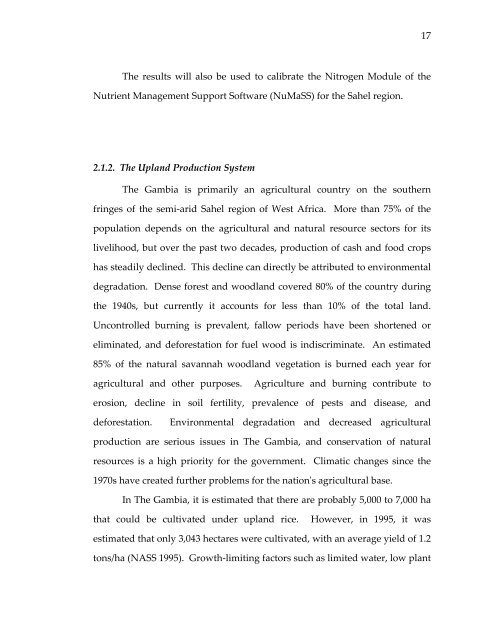Management of rice production systems to increase productivity
Management of rice production systems to increase productivity
Management of rice production systems to increase productivity
Create successful ePaper yourself
Turn your PDF publications into a flip-book with our unique Google optimized e-Paper software.
The results will also be used <strong>to</strong> calibrate the Nitrogen Module <strong>of</strong> the<br />
Nutrient <strong>Management</strong> Support S<strong>of</strong>tware (NuMaSS) for the Sahel region.<br />
2.1.2. The Upland Production System<br />
The Gambia is primarily an agricultural country on the southern<br />
fringes <strong>of</strong> the semi‐arid Sahel region <strong>of</strong> West Africa. More than 75% <strong>of</strong> the<br />
population depends on the agricultural and natural resource sec<strong>to</strong>rs for its<br />
livelihood, but over the past two decades, <strong>production</strong> <strong>of</strong> cash and food crops<br />
has steadily declined. This decline can directly be attributed <strong>to</strong> environmental<br />
degradation. Dense forest and woodland covered 80% <strong>of</strong> the country during<br />
the 1940s, but currently it accounts for less than 10% <strong>of</strong> the <strong>to</strong>tal land.<br />
Uncontrolled burning is prevalent, fallow periods have been shortened or<br />
eliminated, and deforestation for fuel wood is indiscriminate. An estimated<br />
85% <strong>of</strong> the natural savannah woodland vegetation is burned each year for<br />
agricultural and other purposes. Agriculture and burning contribute <strong>to</strong><br />
erosion, decline in soil fertility, prevalence <strong>of</strong> pests and disease, and<br />
deforestation. Environmental degradation and decreased agricultural<br />
<strong>production</strong> are serious issues in The Gambia, and conservation <strong>of</strong> natural<br />
resources is a high priority for the government. Climatic changes since the<br />
1970s have created further problems for the nationʹs agricultural base.<br />
In The Gambia, it is estimated that there are probably 5,000 <strong>to</strong> 7,000 ha<br />
that could be cultivated under upland <strong>rice</strong>. However, in 1995, it was<br />
estimated that only 3,043 hectares were cultivated, with an average yield <strong>of</strong> 1.2<br />
<strong>to</strong>ns/ha (NASS 1995). Growth‐limiting fac<strong>to</strong>rs such as limited water, low plant<br />
17
















